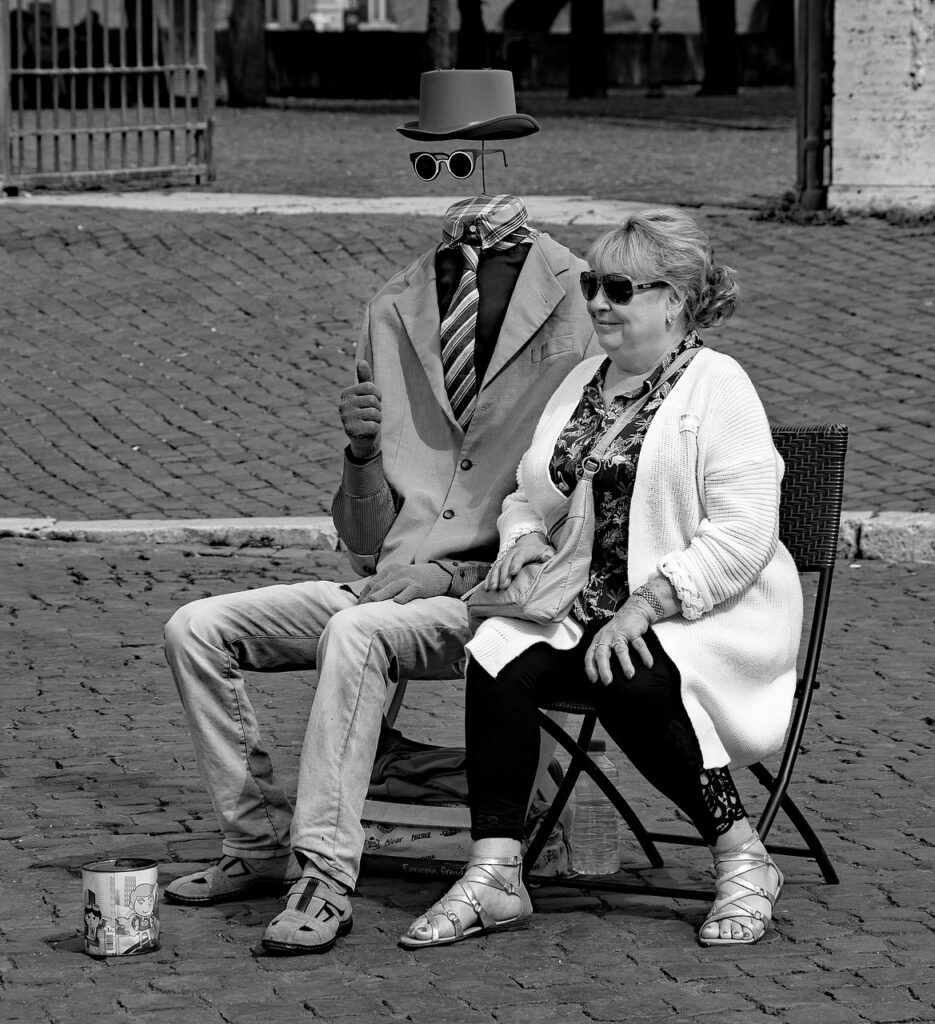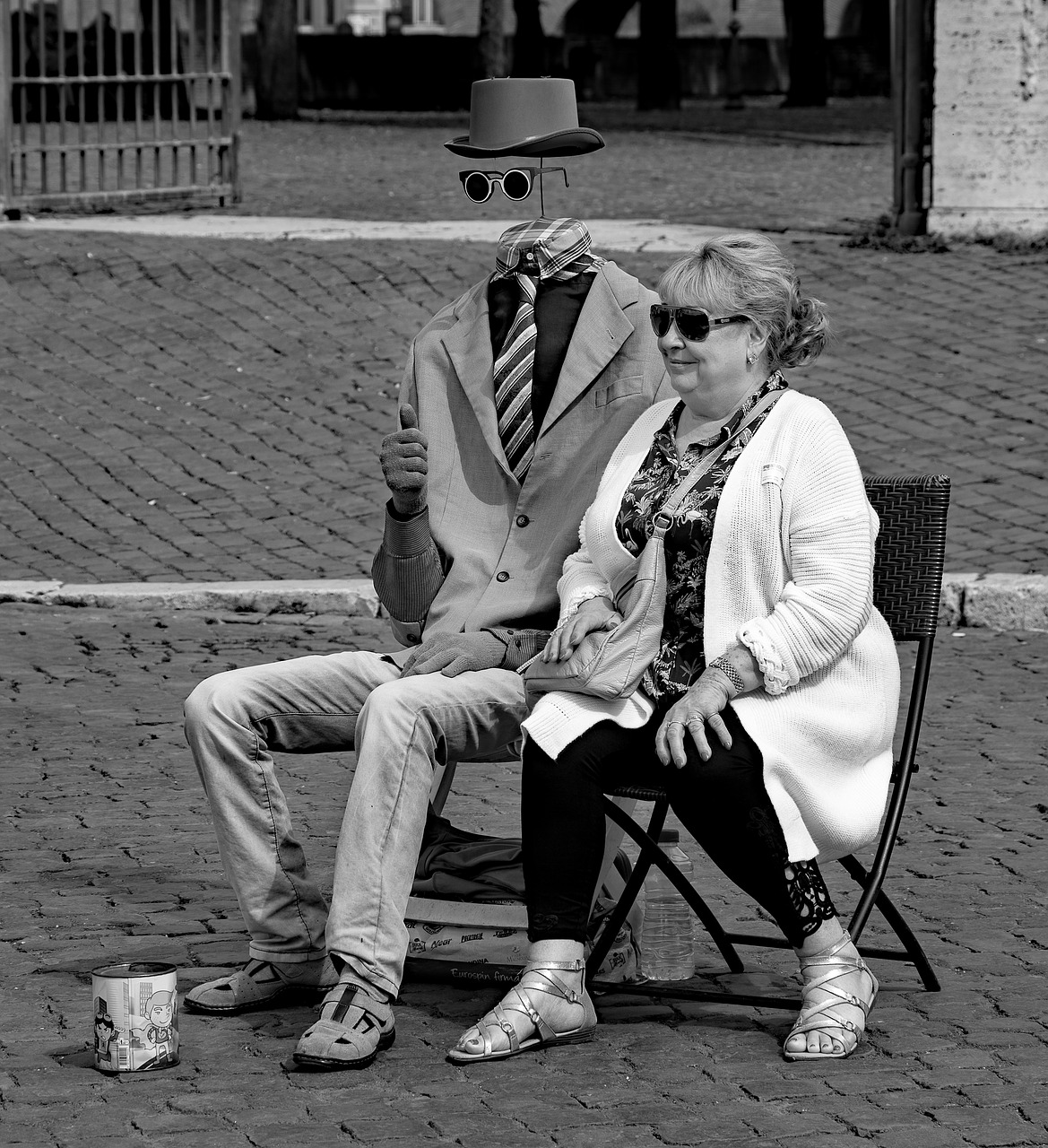GHOST IMPROVISER
Hints and suggestions can excite an audience’s imagination more than all the blatant words and images we forcefully create. Build the outline of a character and the audience will fill in the rest. (usually with the elements of their own lives).
Here’s a “solo” exercise that mixes, impro, mime, and puppetry. Helped by your partners, you are about to create a playful and visual variation of a typical solo scene.

You’ve probably watched or performed a scene where one performer plays all the characters switching voices and behaviours. In the following traditional example of this sort of scene, you are two characters in a bar. A third might eventually enter.
- Standing by the table, YOU, as the waiter, asks YOU 2, the customer sitting at the table), what you would like to drink.
- Customer/You flips through the menu asking about the pub specialty.
- Stand up and move to the place where the waiter should be and YOU/waiter answer in a gruff Irish voice, “Beer”.
- You sit down again, looking at the place where you were just playing the waiter, smile, and YOU/customer ask for a cup of tea….
- Change places again and Waiter/you, stares at the spot where you were just playing the customer. YOU/waiter shakes your head and walk away.
- Sitting back down, YOU/customer pull out the wedding ring from your jacket and practice your proposal to your childhood sweetheart who is about to arrive… played, of course, by YOU.
This is an example of how the solo scene is usually played. These scenes are fun and can serve to get you out of your head a bit as you try to survive the multiple-personality character chaos.
Here’s a twist. With the help of the improvisers watching offstage, you can create a whole new dimension.
In the scene above, your characters might have one or two objects associated with them. The waiter might have a towel on one arm. The customer might wear a hat or glasses.
The offstage improvisers help to keep the invisible characters magically visible. Instead of dropping your character’s hat/waiter towel/glasses/etc as you change characters, another performer holds the hat in the air where your head was when you were sitting. They are the “ghost Improvisers”.
Like puppeteers, they can animate the prop or costume in subtle ways that add to the story. They tilt the hat down as if looking at the menu. They tilt the hat up to “look” at the waiter.
When you (the performer) go back to play the customer, you simply place your head in the correct position under the hat and continue the story, inspired by the position the “ghost improviser” last left the character in.
The “ghost improvisers” can create physical offers to inspire and challenge you.
As you play the waiter character, the “ghost improviser” raises the hat as if the character is standing. The “ghost improviser” moves the hat in a bobbing fashion as if walking towards the window.
improviser” raises the hat as if the character is standing. The “ghost improviser” moves the hat in a bobbing fashion as if walking towards the window.
When YOU go back to play the customer character, you put your head back into the hat which has been turned by the ghost improvisers. This forces you to look out the window. NOW – you have to improvise because the control of the scene has been playfully moved into a new intention.
You quickly make sense of the ghost improvisers’ offer. As you stare out the window, you see your girlfriend walking toward the bar. You turn to the waiter (now just a floating bar towel by the table where you left him). Full of fear you ask him if you should propose to your childhood sweetheart.
The table cloth “walks” towards you and we imagine the bartender approaching…
There’s great potential and elegant magic in this style. The audience’s imagination is kicked into a higher gear as they fill in the picture that the Ghost Improvisers imply. And the solo performer gets another level of challenge as the Ghost Improviser adapts to what is in the scene, supports the solo performer, and creates offers to advance the story.
- Play with costume pieces – scarves, glasses, hats, etc.
- Play with actions – doors opening, pages in books turning, objects being thrown.
- Interaction is great too. The Ghost character places a hand on your shoulder so that when you switch into being that character you must remember to have your hand out onto the place where the other character was just sitting.
- The Ghost Improviser can take risks with emotions as well with the speed and directness or softness in their movement.
It may seem a little confusing to read about but you’ll make great discoveries when you share the possibility of playing all the characters with the Ghost Improvisers who can motivate you into exploring the unseen edges of possibility.
Have fun. Explore.




0 Comments